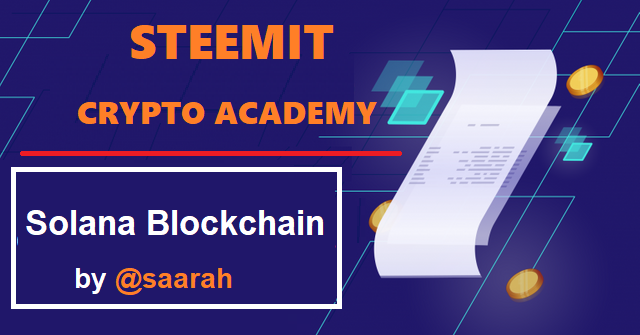Hello everybody, Hope you all are fine and in good health!
My this post is a Homework Task assigned by professor @pelon53 which is about Solana Blockchain

1) Explain in detail the PoH of Solana.
Solana blockchain is one of the many potential blockchain protocols that aim to address the impossible issues of transaction speed, cost and scalability on the network. The thing that sets Solana apart from others is ii is actually moving forward by implementing new protocols and mechanisms to practically solve these issues rather than just having advertisement goals.
The use of proof of history consensus is one such prominent feature of the platform. The proof of history consensus algorithm enables the network to record transactions along with the timestamp so that it can be traced when the transaction happened.
The blockchain uses Verifiable Delay Function algorithm or VDFs which after a number of steps assigns hash with a publicly verifiable value. Thus, Proof of history consensus acts as a native clock of the network. The nodes have cryptographic clocks to trace network and transaction timings.
This allows quick interpretation of events and high processing rates. POH functions by hashing data; the output of the first becomes the input of the next with the addition of specified details. In simpler words POH creates a continuous long chain of hashes in sequential manner arranged in the sequence when the transactions occurred.
This eliminates the need of traditional timestamps and the validators can validate the transaction and the length of time it took for the elapsed hash. VDFs work with Tower BFT on the network to reduce the cost of transferring a message or a delay in validation.

2) Explain at least 2 cases of use of Solana.
Cyclos
It is one of the market providers based on the Solana ecosystem. It works similar to a DEX and we can even swap coins here. It works on the AMM mechanism. It also presents the feature of order books as present in centralized exchanges. On the platform you find exchange pools, various swapping pairs etc.
CYS is the native token of the Cyclos platform. The token deploys smart-contracts based on the Solan Network for various functions on the platform. The current stats of CYS according to coinmarketcap.com are available here.
Serum
Another platformer use case which has its roots in the Solana blockchain is Serum. It is a decentralized exchange. The network boasts itself to be free from any kind of centralized behavior. However It too features an order boom much like centralized exchanges. It also allows fast-swapping of coins and we can use numerous crypto pairs with USDT and USDC stable coins.
It is an open-source platform. It allows for the construction of DEX games and much more. The native token is serum, the details of which can be found here.

3)
Detail and explain the SOLA token.
The Sola token is listed on Coingecko and is trading at
Sola token is the native token of a decentralized exchange known by the name Sola. According to coingecko the price of the token US$0,058806 and other important details is:
Rank: 1810
Circulating Supply: 27.153.077 Sola
Max Supply: 27.153.077 Sola
Market Cap: US$1.664.565
Trading volume in 24h: US$54.261
The token is used as a token for governance and of investment. Stakers stake Sola and take part in the decisions of the network. It is yet not listed on other exchanges and is traded only on the https://solatoken.net/. It is not even available on coinmarketcap.com

4) When did Solana Blockchain see its operations interrupted? Why? Explain.
The Solan Network suffered what we called a blackout or complete shut down on 14th September 2021. The network remained down for about 24 hours. As the main network died so did the forks and the smart contracts related to it.
According to officials there was an exhaustion of resources due to the enormous number of transactions that peaked to 400,000 per second. These were due to an increase in the price of an asset from a lower 2$ to a tremendous 200$ within 6 months.
According to a tweet
The network is capable of managing 65,000 TPS but a 400,000 TPS was completely out of range. According to many around the use of bots in making transactions to participate in the issuance of the Grape Protocol (GRAPE) flooded the network and resulted in a complete shutdown.
The nodes then voted on to restart the network. The network hence was restarted in a span of about 2 hours. The restart is for many a surprise a question mark on the network which boasts itself to be completely decentralized.

5) Check the last block generated in Solana and make an approximate calculation of How many blocks per second have been generated in Solana, taking into account from the initial block to the current one? Justify your answer and show screenshots.
I went to the https://explorer.solana.com/ to find the last block generated
- The last block was 99308732
- It is dated to 0ct 1
To make an approximate calculation of the block validation time we should know the date or time of the first block
But here is no date or time for approximation we can since Solana was launch in March and up till 1st Oct, we have 99308732 blocks
Then this for 19 months
For 1 month it would be =99308732/19= 5226775.36842 blocks
in 1 seconds = 5226775.36842/2592000= 2.01650284275
Thus, we can say that in 1 sec we have 2.01650284275 or approximately 2 blocks and one block is generated in 0.5 sec.

Conclusion
I tried my best to provide detailed answers and satisfy every question with accurate information. To my understanding Solana is no doubt a prosperous project with the implementation of various new technologies it has surely made transactions fast and cost-effective